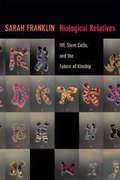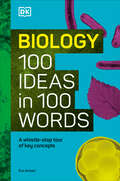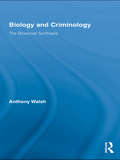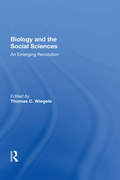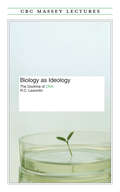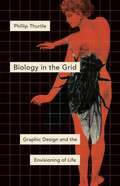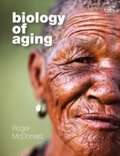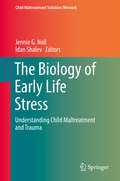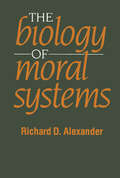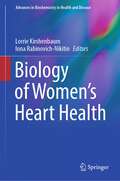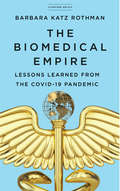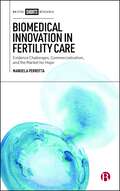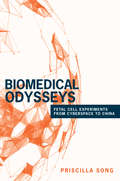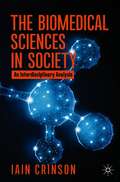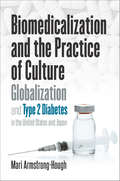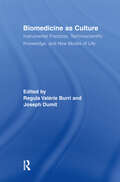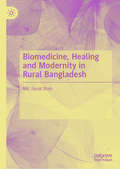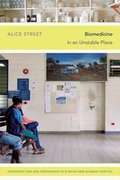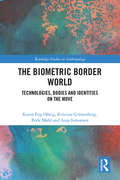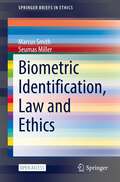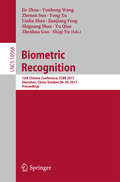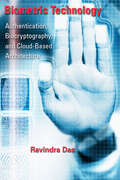- Table View
- List View
Biological Relatives: IVF, Stem Cells, and the Future of Kinship
by Sarah FranklinThirty-five years after its initial success as a form of technologically assisted human reproduction, and five million miracle babies later, in vitro fertilization (IVF) has become a routine procedure worldwide. In Biological Relatives, Sarah Franklin explores how the normalization of IVF has changed how both technology and biology are understood. Drawing on anthropology, feminist theory, and science studies, Franklin charts the evolution of IVF from an experimental research technique into a global technological platform used for a wide variety of applications, including genetic diagnosis, livestock breeding, cloning, and stem cell research. She contends that despite its ubiquity, IVF remains a highly paradoxical technology that confirms the relative and contingent nature of biology while creating new biological relatives. Using IVF as a lens, Franklin presents a bold and lucid thesis linking technologies of gender and sex to reproductive biomedicine, contemporary bioinnovation, and the future of kinship.
Biologically Modified Justice
by Colin FarrellyTheories of distributive justice tend to focus on the issue of what constitutes a fair division of 'external' goods and opportunities; things like wealth and income, opportunities for education and basic liberties and rights. However, rapid advances in the biomedical sciences have ushered in a new era, one where the 'genetic lottery of life' can be directly influenced by humans in ways that would have been considered science fiction only a few decades ago. How should theories of justice be modified to take seriously the prospect of new biotechnologies, especially given the health challenges posed by global aging? Colin Farrelly addresses a host of topics, ranging from gene therapy and preimplantation genetic diagnosis, to an 'anti-aging' intervention and the creation and evolution of patriarchy. This book aims to foster the interdisciplinary dialogue needed to ensure we think rationally and cogently about science and science policy in the twenty-first century.
Biology 100 Ideas in 100 Words: A Whistle-stop Tour of Science’s Key Concepts
by Eva AmsenBiology Ideas in 100 Words offers the essential facts at your fingertips, satisfying your scientific curiosity and helping you to understand the biggest concepts in biology in concise, 100-word summaries.One of the titles in a cutting-edge new series created in partnership with The Science Museum, this book introduces 100 key areas of biology-such as life processes, evolution, DNA and inheritance, diversity of plants, immunity, and disease-and explains each topic in just 100 words. Perfect for getting your head around big ideas clearly and quickly or refreshing your memory of the fundamentals of life on earth, this book covers the most up-to-date terms and theories and inspires a heightened level of understanding and enjoyment to the core areas of biology explored in The Science Museum.
Biology and Criminology: The Biosocial Synthesis (Routledge Advances in Criminology)
by Anthony WalshNumerous criminologists have noted their dissatisfaction with the state of criminology. The need for a new paradigm for the 21st century is clear. However, many distrust biology as a factor in studies of criminal behavior, whether because of limited exposure or because the orientation of criminology in general has a propensity to see it as racist, classist, or at least illiberal. This innovative new book by noted criminologist Anthony Walsh dispels such fears, examining how information from the biological sciences strengthens criminology work and both complements and improves upon traditional theories of criminal behavior. With its reasoned case for biological science as a fundamental tool of the criminologist, Walsh's groundbreaking work will be required reading for all students and faculty within the field of criminology.
Biology And The Social Sciences: An Emerging Revolution
by Thomas C. WiegeleExciting new developments in behavioral biology are creating an intellectual revolution in the study of human behavior and are causing social scientists to reassess the ways in which they approach their disciplines. This book examines how these new findings are likely to transform and shape anthropology, sociology, economics, and political science in the coming decade. The book begins with an overview of the rapidly changing relationship between biological and social studies. In successive sections, well-known social scientists, biologists, and philosophers address the theoretical challenges involved in incorporating material from sociobiology, ecology, genetics, and psychophysiology into their own disciplines' approaches to the analysis of human behavior. The concluding chapters examine specific methodological problems and related issues.
Biology As Ideology: The Doctrine of DNA (The CBC Massey Lectures)
by Richard LewontinR. C. Lewontin is a prominent scientist -- a geneticist who teaches at Harvard -- yet he believes that we have placed science on a pedestal, treating it as an objective body of knowledge that transcends all other ways of knowing and all other endeavours.Lewontin writes in this collection of essays, which began their life as CBC Radio's Massey Lectures Series for 1990: "Scientists do not begin life as scientists, after all, but as social beings immersed in a family, a state, a productive structure, and they view nature through a lens that has been molded by their social experience… . Science, like the Church before it, is a supremely social institution, reflecting and reinforcing the dominant values and vices of society at each historical epoch."In Biology as Ideology Lewontin examines the false paths down which modern scientific ideology has led us. By admitting science's limitations, he helps us rediscover the richness of nature -- and appreciate the real value of science.
Biology in the Grid: Graphic Design and the Envisioning of Life (Posthumanities)
by Phillip ThurtleHow grids paved the way for our biological understanding of organisms As one of the most visual sciences, biology has an aesthetic dimension that lends force and persuasion to scientific arguments: how things are arranged on a page, how texts are interspersed with images, and how images are composed reflect deep-seated beliefs about how life exists on Earth. Biology in the Grid traces how our current understanding of life and genetics emerged from the pervasive nineteenth- and twentieth-century graphic form of the grid, which allowed disparate pieces of information to form what media theorist Vilém Flusser called &“technical images.&”Phillip Thurtle explains how the grid came to dominate biology in the twentieth century, transforming biologists&’ beliefs about how organisms were constructed. He demonstrates how this shift in our understanding of biological grids enabled new philosophies in endeavors such as advertising, entertainment, and even political theory. The implications of the arguments in Biology in the Grid are profound, touching on matters as fundamental as desire, our understanding of our bodies, and our view of how society is composed. Moreover, Thurtle&’s beautifully written, tightly focused arguments allow readers to apply his claims to new disciplines and systems. Bristling with insight and potential, Biology in the Grid ultimately suggests that such a grid-organized understanding of natural life inevitably has social and political dimensions, with society recognized as being made of interchangeable, regulated parts rather than as an organic whole.
Biology Of Aging
by Roger B. McDonaldBiology of Aging presents the biological principles that have led to a new understanding of the causes of aging and describes how these basic principles help one to understand the human experience of biological aging, longevity, and age-related disease. Intended for undergraduate biology students, it describes how the rate of biological aging is measured; explores the mechanisms underlying cellular aging; discusses the genetic pathways that affect longevity in various organisms; outlines the normal age-related changes and the functional decline that occurs in physiological systems over the lifespan; and considers the implications of modulating the rate of aging and longevity. The book also includes end-of-chapter discussion questions to help students assess their knowledge of the material.
The Biology of Early Life Stress: Understanding Child Maltreatment and Trauma (Child Maltreatment Solutions Network)
by Jennie G. Noll Idan ShalevThis innovative collection extends the emerging field of stress biology to examine the effects of a substantial source of early-life stress: child abuse and neglect. Research findings across endocrinology, immunology, neuroscience, and genomics supply new insights into the psychological variables associated with adversity in children and its outcomes. These compelling interdisciplinary data add to a promising model of biological mechanisms involved in individual resilience amid chronic maltreatment and other trauma. At the same time, these results also open out distinctive new possibilities for serving vulnerable children and youth, focusing on preventing, intervening in, and potentially even reversing the effects of chronic early trauma.Included in the coverage:Biological embedding of child maltreatmentToward an adaptation-based approach to resilience Developmental traumatology: brain development and maltreated children with and without PTSDChildhood maltreatment and pediatric PTSD: abnormalities in threat neural circuitryAn integrative temporal framework for psychological resilienceThe Biology of Early Life Stress is important reading for child maltreatment researchers; clinical psychologists; educators in counseling, psychology, trauma, and nursing; physicians; and state- and federal-level policymakers. Advocates, child and youth practitioners, and clinicians in general will find it a compelling resource.
The Biology of Moral Systems
by Richard AlexanderFirst published in 1987, this book discusses the life and natural history of moral systems as seen through the eyes of a biologist. The volume offers a comprehensive introspective of the biology of a moral system by examining the evolutionary approach from perspectives of sociobiology and ideology. Morality in relation to conflicts and confluences of interest among humankind are further evaluated, with particular emphasis on the human psyche and the ontogeny of moral behaviour. Philosophical meets biological with insightful commentary on the morality of law and democracy. The book concludes with an epilogue, bibliography and name and subject index. It is clear, concise and contemporary and would be of use to those studying Biology, Philsophy and many other social sciences.
The Biology of Violence: How Understanding the Brain, Behavior, and Environment Can Break the Vicious Circle of Aggression
by Debra NiehoffDebra Niehoff's book is one of the first to examine violence from a complete biological perspective. She ascertains that by understanding human biology, we can control violence in our society. She brings together a wide range of research to support her premise.
Biology of Women’s Heart Health (Advances in Biochemistry in Health and Disease #26)
by Lorrie Kirshenbaum Inna Rabinovich-NikitinCardiovascular disease (CVD) is the leading cause of morbidity and mortality in women and men worldwide and represents a major financial burden to world health care systems. Importantly, CVD has eclipsed cancer as the leading cause of death for women globally. Through advancements in research and clinical testing, the symptoms and risk factors for CVD have been well established for men, but not for women. Consequently, there is an immediate need for new innovative research that will bridge this gap and allow for improved early diagnosis and treatment of CVD in women. This book will serve as a guide for health care providers to better understand the physiological, biochemical, and genetic differences in heart disease in women with the goal of providing improved education, awareness and treatment of cardiovascular disease in women. The book will cover topics such as: sex dependent clinical outcomes of cardiovascular disease, cardiac protection by estrogen, cardiac health during menopause, cardiac rehabilitation programs, fitness and exercise, cardio-oncology, shift work and the CVD risk, and pregnancy related CVD.
The Biomedical Empire: Lessons Learned from the COVID-19 Pandemic
by Barbara Katz RothmanWe are all citizens of the Biomedical Empire, though few of us know it, and even fewer understand the extent of its power. In this book, Barbara Katz Rothman clarifies that critiques of biopower and the "medical industrial complex" have not gone far enough, and asserts that the medical industry is nothing short of an imperial power. Factors as fundamental as one's citizenship and sex identity—drivers of our access to basic goods and services—rely on approval and legitimation by biomedicine. Moreover, a vast and powerful global market has risen up around the empire, making it one of the largest economic forces in the world. Katz Rothman shows that biomedicine has the key elements of an imperial power: economic leverage, the faith of its citizens, and governmental rule. She investigates the Western colonial underpinnings of the empire and its rapid intrusion into everyday life, focusing on the realms of birth and death. This provides her with a powerful vantage point from which to critically examine the current moment, when the COVID-19 pandemic has exposed the power structures of the empire in unprecedented ways while sparking the most visible resistance it has ever seen.
Biomedical Innovation in Fertility Care: Evidence Challenges, Commercialization, and the Market for Hope
by Manuela PerrottaAvailable Open Access digitally under CC-BY-NC-ND licence.This book analyses the clashes between evidence-based medicine and the dynamics of an increasingly privatised fertility care industry. With a unique focus on "add-on" treatments, it reveals how these controversial treatments are now widespread and can border on hopemongering.
Biomedical Odysseys: Fetal Cell Experiments from Cyberspace to China
by Priscilla SongThousands of people from more than eighty countries have traveled to China since 2001 to undergo fetal cell transplantation. Galvanized by the potential of stem and fetal cells to regenerate damaged neurons and restore lost bodily functions, people grappling with paralysis and neurodegenerative disorders have ignored the warnings of doctors and scientists back home in order to stake their futures on a Chinese experiment. Biomedical Odysseys looks at why and how these individuals have entrusted their lives to Chinese neurosurgeons operating on the forefront of experimental medicine, in a world where technologies and risks move faster than laws can keep pace. Priscilla Song shows how cutting-edge medicine is not just about the latest advances in biomedical science but also encompasses transformations in online patient activism, surgical intervention, and borderline experiments in health care bureaucracy.Bringing together a decade of ethnographic research in hospital wards, laboratories, and online patient discussion forums, Song opens up important theoretical and methodological horizons in the anthropology of science, technology, and medicine. She illuminates how poignant journeys in search of fetal cell cures become tangled in complex webs of digital mediation, the entrepreneurial logics of postsocialist medicine, and fraught debates about the ethics of clinical experimentation.Using innovative methods to track the border-crossing quests of Chinese clinicians and their patients from around the world, Biomedical Odysseys is the first book to map the transnational life of fetal cell therapies.
The Biomedical Sciences in Society: An Interdisciplinary Analysis
by Iain CrinsonThis textbook provides a comprehensive introduction to the interdisciplinary field of the Social Studies of Science and Technology (SSST). Over the past two decades, the biomedical sciences have transformed our understanding of the relationship between the social and natural worlds, while its ‘promissory visions’ are seen to offer extraordinary opportunities for economic and social development. But alongside these scientific innovations have emerged new, and frequently unanticipated social, political, bioethical, and legal dilemmas and challenges. This cutting-edge text explores ‘post-genomic’ developments in the field of pharmacogenomics and the prospects for a new ‘precision’ or personalised medicine; the potential of environmental epigenetics to reconfigure the boundaries of the social and natural worlds; the emergence of an array of ‘neuro-disciplines’, seeking to identify the neural basis of a whole range of social and economic behaviours; and the challenges of constructing a coherent and robust governance framework for the conduct of biomedical science research and innovation, responsive to the social and health needs of the whole population.
Biomedicalization and the Practice of Culture: Globalization and Type 2 Diabetes in the United States and Japan (Studies in Social Medicine)
by Mari Armstrong-HoughOver the last twenty years, type 2 diabetes skyrocketed to the forefront of global public health concern. In this book, Mari Armstrong-Hough examines the rise in and response to the disease in two societies: the United States and Japan. Both societies have faced rising rates of diabetes, but their social and biomedical responses to its ascendance have diverged. To explain the emergence of these distinctive strategies, Armstrong-Hough argues that physicians act not only on increasingly globalized professional standards but also on local knowledge, explanatory models, and cultural toolkits. As a result, strategies for clinical management diverge sharply from one country to another. Armstrong-Hough demonstrates how distinctive practices endure in the midst of intensifying biomedicalization, both on the part of patients and on the part of physicians, and how these differences grow from broader cultural narratives about diabetes in each setting.
Biomedicine as Culture: Instrumental Practices, Technoscientific Knowledge, and New Modes of Life (Routledge Studies in Science, Technology and Society)
by Joseph Dumit Regula Valérie BurriThis volume offers interdisciplinary perspectives on contemporary biomedicine as a cultural practice. It brings together leading scholars from cultural anthropology, sociology, history, and science studies to conduct a critical dialogue on the culture(s) of biomedical practice, discussing its epistemic, material, and social implications. The essays look at the ways new biomedical knowledge is constructed within hospitals and academic settings and at how this knowledge changes perceptions, material arrangements, and social relations, not only within clinics and scientific communities, but especially once it is diffused into a broader cultural context.
Biomedicine, Healing and Modernity in Rural Bangladesh
by Md. Faruk ShahThis book provides an ethnographic account of the ways in which biomedicine, as a part of the modernization of healthcare, has been localized and established as the culturally dominant medical system in rural Bangladesh. Dr Faruk Shah offers an anthropological critique of biomedicine in rural Bangladesh that explains how the existing social inequalities and disparities in healthcare are intensified by the practices undertaken in biomedical health centres through the healthcare bureaucracy and local gendered politics. This work of villagers’ healthcare practices leads to a fascinating analysis of the local healthcare bureaucracy, corruption, structural violence, commodification of health, pharmaceutical promotional strategies and gender discrimination in population control. Shah argues that biomedicine has already achieved cultural authority and acceptability at almost all levels of the health sector in Bangladesh. However, in this system healthcare bureaucracy is shaped by social capital, power relations and kin networks, and corruption is a central element of daily care practices.
Biomedicine in an Unstable Place: Infrastructure and Personhood in a Papua New Guinean Hospital
by Alice StreetBiomedicine in an Unstable Place is the story of people's struggle to make biomedicine work in a public hospital in Papua New Guinea. It is a story encompassing the history of hospital infrastructures as sites of colonial and postcolonial governance, the simultaneous production of Papua New Guinea as a site of global medical research and public health, and people's encounters with urban institutions and biomedical technologies. In Papua New Guinea, a century of state building has weakened already inadequate colonial infrastructures, and people experience the hospital as a space of institutional, medical, and ontological instability.In the hospital's clinics, biomedical practitioners struggle amid severe resource shortages to make the diseased body visible and knowable to the clinical gaze. That struggle is entangled with attempts by doctors, nurses, and patients to make themselves visible to external others--to kin, clinical experts, global scientists, politicians, and international development workers--as socially recognizable and valuable persons. Here hospital infrastructures emerge as relational technologies that are fundamentally fragile but also offer crucial opportunities for making people visible and knowable in new, unpredictable, and powerful ways.
The Biometric Border World: Technology, Bodies and Identities on the Move (Routledge Studies in Anthropology)
by Karen Fog Olwig Kristina Grünenberg Perle Møhl Anja SimonsenSince the 1990s, biometric border control has attained key importance throughout Europe. Employing digital images of, for example, fingerprints, DNA, bones, faces or irises, biometric technologies use bodies to identify, categorize and regulate individuals’ cross-border movements. Based on innovative collaborative fieldwork, this book examines how biometrics are developed, put to use and negotiated in key European border sites. It analyses the disparate ways in which the technologies are applied, perceived and experienced by border control agents and others managing the cross-border flow of people, by scientists and developers engaged in making the technologies, and by migrants and non-government organizations attempting to manoeuvre in the complicated and often-unpredictable systems of technological control. Biometric technologies are promoted by national and supranational authorities and industry as scientifically exact and neutral methods of identification and verification, and as an infallible solution to security threats. The ethnographic case studies in this volume demonstrate, however, that the technologies are, in fact, characterized by considerable ambiguity and uncertainty and subject to substantial subjective interpretation, translation and brokering with different implications for migrants, border guards, researchers and other actors engaged in the border world.
Biometric Identification, Law and Ethics (SpringerBriefs in Ethics)
by Marcus Smith Seumas MillerThis book is open access. This book undertakes a multifaceted and integrated examination of biometric identification, including the current state of the technology, how it is being used, the key ethical issues, and the implications for law and regulation. The five chapters examine the main forms of contemporary biometrics–fingerprint recognition, facial recognition and DNA identification– as well the integration of biometric data with other forms of personal data, analyses key ethical concepts in play, including privacy, individual autonomy, collective responsibility, and joint ownership rights, and proposes a raft of principles to guide the regulation of biometrics in liberal democracies.Biometric identification technology is developing rapidly and being implemented more widely, along with other forms of information technology. As products, services and communication moves online, digital identity and security is becoming more important. Biometric identification facilitates this transition. Citizens now use biometrics to access a smartphone or obtain a passport; law enforcement agencies use biometrics in association with CCTV to identify a terrorist in a crowd, or identify a suspect via their fingerprints or DNA; and companies use biometrics to identify their customers and employees. In some cases the use of biometrics is governed by law, in others the technology has developed and been implemented so quickly that, perhaps because it has been viewed as a valuable security enhancement, laws regulating its use have often not been updated to reflect new applications. However, the technology associated with biometrics raises significant ethical problems, including in relation to individual privacy, ownership of biometric data, dual use and, more generally, as is illustrated by the increasing use of biometrics in authoritarian states such as China, the potential for unregulated biometrics to undermine fundamental principles of liberal democracy. Resolving these ethical problems is a vital step towards more effective regulation.
Biometric Recognition: 12th Chinese Conference, CCBR 2017, Shenzhen, China, October 28-29, 2017, Proceedings (Lecture Notes in Computer Science #10568)
by Jie Zhou Zhenhua Guo Yong Xu Shiguang Shan Yunhong Wang Zhenan Sun Jianjiang Feng Linlin Shen Yu Qiao Shiqi YuWith the increasing concerns on security breaches and transaction fraud, highly reliable and convenient personal verification and identification technologies are more and more requisite in our social activities and national services. Biometrics, used to recognize the identity of an individual, are gaining ever-growing popularity in an extensive array of governmental, military, forensic, and commercial security applications. ""Advanced Biometric Recognition Technologies: Discriminant Criterion and Fusion Applications"" focuses on two kinds of advanced biometric recognition technologies, biometric data discrimination and multi-biometrics, while systematically introducing recent research in developing effective biometric recognition technologies. Organized into three main sections, this cutting-edge book explores advanced biometric data discrimination technologies, describes tensor-based biometric data discrimination technologies, and develops the fundamental conception and categories of multi-biometrics technologies.
Biometric State
by Keith BreckenridgeGroundbreaking study of South Africa's role as a site for global experiments in biometric identification throughout the twentieth century.
Biometric Technology: Authentication, Biocryptography, and Cloud-Based Architecture
by Ravi DasMost biometric books are either extraordinarily technical for technophiles or extremely elementary for the lay person. Striking a balance, this book is geared toward the business, IT, or security manager required to make purchasing, migration, or adoption decisions. Presenting technical background on the various biometric technologies and how they work, it looks at optimal application in various settings and their respective strengths and weaknesses considering ease of use, false positives and negatives, and privacy and security issues. It also discusses exciting trends in biotechnology such as biocryptography and biometrics in the cloud.
